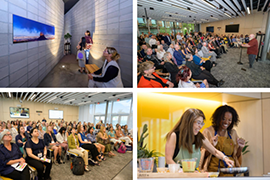 The new Andrew Weil Center for Integrative Medicine complex – the “Mind,” “Body” and “Spirit” buildings (the Body building also being known as the Iris Cantor Building) were designed from the start to embody all seven domains of integrative health: sleep, resilience, movement, relationships, nutrition, spirituality, and environment.
The new Andrew Weil Center for Integrative Medicine complex – the “Mind,” “Body” and “Spirit” buildings (the Body building also being known as the Iris Cantor Building) were designed from the start to embody all seven domains of integrative health: sleep, resilience, movement, relationships, nutrition, spirituality, and environment.
 While the working spaces of the building will support health and wellbeing for AWCIM staff, many aspects of the surrounding spaces will be accessible to the general campus community and beyond.
While the working spaces of the building will support health and wellbeing for AWCIM staff, many aspects of the surrounding spaces will be accessible to the general campus community and beyond.
The buildings are set in a desert garden landscape with connection to a neighboring University of Arizona green space, allowing employees – indeed anyone on campus or the public – places to walk and go offline for breaks throughout the day: a feature supporting the Environment domain of integrative health.
Water retention and detention features of the complex conserve water to maintain the plantings, which include an herbal medicinal plant garden and fruit trees reminding visitors of healthy Nutrition.
A teaching kitchen in the Cantor Building will further support healthy nutrition practices, while offering an inviting gathering space to support Relationships – another domain of integrative health.
That same space will be used for the many educational trainings that the Center offers to health professionals at all stages of their careers and will also be used for Tai Chi and Yoga classes – to support the Spirituality domain of integrative health.![The Andrew Weil Center for Integrative Medicine complex of buildings combines natural surroundings of the desert complimented by the built environment to enhance wellbeing. [The Andrew Weil Center for Integrative Medicine complex of buildings combines natural surroundings of the desert complimented by the built environment to enhance wellbeing.]](/sites/default/files/awcim-courtyard_350x145px.jpg)
The Spirit Building itself and an ADA-accessible labyrinth in the desert gardens will allow for meditation breaks, to reduce stress and energize during the day – supporting both the Spirituality and Resilience domains of integrative health.
![Some spaces prove inspirational for meditation and reenergizing contemplation. [Some spaces prove inspirational for meditation and reenergizing contemplation.]](/sites/default/files/meditation_awcim_270x180px.jpg) The research-dedicated Recharge Room, donated by Studio Elsewhere, provides a nature immersive reality space for recharging and de-stressing, to support Resilience as well as for carrying out quantitative studies on the effects of immersive nature reality on wellbeing. Unique to the Center is the Flourish component of the Recharge Room, combining light and music to energize and connect those using it.
The research-dedicated Recharge Room, donated by Studio Elsewhere, provides a nature immersive reality space for recharging and de-stressing, to support Resilience as well as for carrying out quantitative studies on the effects of immersive nature reality on wellbeing. Unique to the Center is the Flourish component of the Recharge Room, combining light and music to energize and connect those using it.
These are just some of the resources and facilities that will be available for faculty & staff to experience at the new AWCIM building complex to promote wellness, reduce stress and improve workplace positivity. For more details and information about specific events and access, go to awcim.arizona.edu.
Banner Recharge Rooms & Spaces
You’ll find additional spaces to recharge at Banner – University Medical Center Tucson which has a recharge room in Tower 1 — the main hospital building (where the entrance is now) — next to the entry to the 7NS (North-South) MICU wing. A control board allows you to pick different scenery to project on the wall with music, including images from the Redwood Forest and other national parks (Click images to enlarge.).
In addition, there are smaller spaces known as waterfall rooms adjacent to the BUMCT elevators off almost every floor. And on the first floor off the Diamond Children’s entrance there are several spaces including play areas, a library and a meditation room.
At Banner – University Medical Center South in the basement next to the cafeteria is an open-air recharge
space that also serves on occasion as a place for special events and dining opportunities such as during Cinco de Mayo.
At Banner – University Medicine North and the University of Arizona Cancer Center Peter & Paula Fasseas Cancer Clinic there, the grounds between and around the UACC clinic and Building 2 have pathways with desert landscaping as well that attract hummingbirds and other fauna.
ALSO SEE:
“Andrew Weil Center for Integrative Medicine to host opening events, May 4” | Posted April 23, 2024


